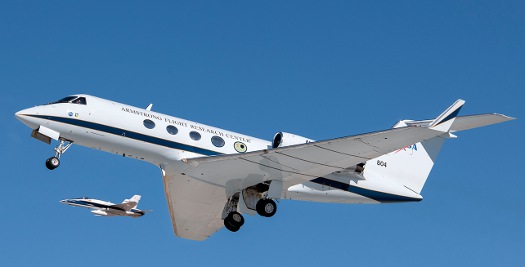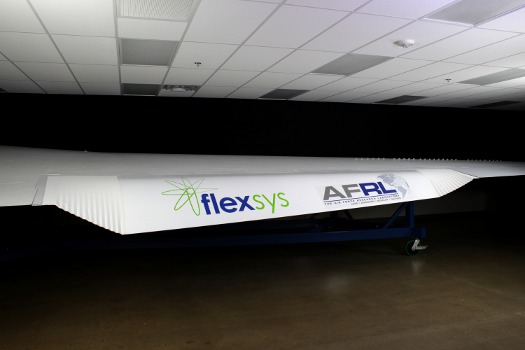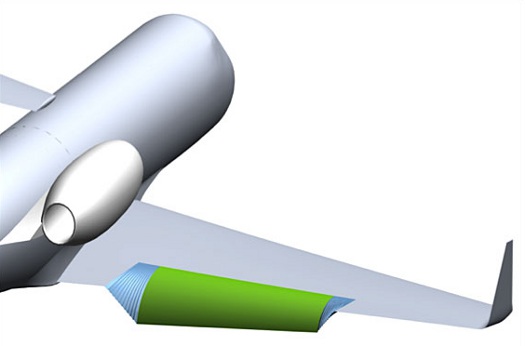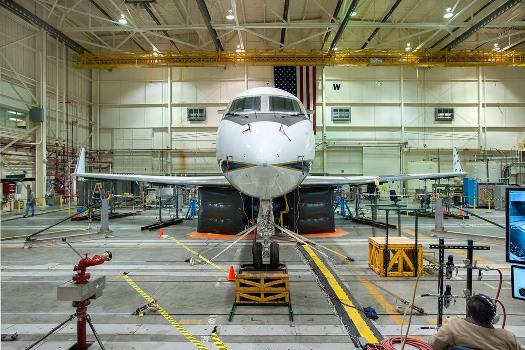 |
| June 20, 2017 | Volume 13 Issue 23 |
Designfax weekly eMagazine
Archives
Partners
Manufacturing Center
Product Spotlight
Modern Applications News
Metalworking Ideas For
Today's Job Shops
Tooling and Production
Strategies for large
metalworking plants
Wings:
NASA flight-tests flexible, twistable wing flaps for improved aerodynamic efficiency

Initial flight-testing of the Adaptive Compliant Trailing Edge (ACTE) followed extensive wind tunnel experiments. For the first phase of ACTE flights, the experimental control surfaces were locked at a specified setting. Varied flap settings on subsequent tests are now demonstrating the capability of the flexible surfaces under actual flight conditions. A modified Gulfstream III is the test bed aircraft for the ACTE flexible-flap research project. [Credits: Ken Ulbrich]
NASA has conducted a series of flights investigating the benefits of twistable, flexible wing flaps to improve flight efficiency.
The second series of Adaptive Compliant Trailing Edge flights, or ACTE II, was flown at NASA's Armstrong Flight Research Center in Edwards, CA, this spring and continued three areas of research based on knowledge gained from the project's first series, which flew in 2014 and 2015.

FlexSys ACTE flap technology bridges gaps in wing for a seamless surface. [Credits: Flexsys Image]
The ACTE project began as a joint effort between NASA and the U.S. Air Force Research Laboratory, or AFRL, to investigate the ability of shape-changing surfaces to determine if advanced flexible trailing-edge wing flaps can both improve aircraft aerodynamic efficiency and reduce airport-area noise generated during takeoffs and landings. In 2014, engineers replaced the conventional aluminum wing flap on NASA's Gulfstream-III Subsonic Research Aircraft Testbed, or SCRAT, with a seamless, twistable flap, patented and built by FlexSys, Inc. of Ann Arbor, MI.
ACTE II advanced several steps from the project's initial phase, including validation of the technology at higher speeds, investigation of the flap's impact on drag, and the first-ever flights of a twisted flap configuration.
The completion of a flight with a twisted flap configuration through ACTE II marks a major milestone for compliant-structure technology. The flight featured the flap set in such a way that different areas of the flap were deflected in different positions. The purpose of this flight was to demonstrate the ability to fly with a twisted configuration.
This research is part of an innovative effort to use hyperelastic materials to produce flexible and seamless aircraft structures that reduce drag and minimize acoustic noise. Hyperelastic materials, such as rubber, have a non-linear stress-strain relationship, which often complicates the modeling process. Researchers are investigating the properties of hyperelastic materials and developing improved finite element analysis (FEA) models. This technology has been shown to improve aircraft aerodynamic efficiency and reduce airport-area noise generated during takeoffs and landings.

[Credits: FlexSys]
To accomplish the twisted flap configuration, engineers deflected the inboard and outboard sections of the flap in opposite degrees. In this particular test series, the flap was arranged so that the inboard section was deflected 2.5 degrees down, while the outboard edge was deflected 2.5 degrees up.
The potential advantage of such a configuration is the ability to change where the center of lift is on the wing, such as how and where the wing responds to wind gusts. Accomplishing this can lead to future wing designs that are much lighter, making the aircraft more efficient, explains SCRAT chief engineer Ethan Baumann.
"We're twisting the inboard and outboard sides of the flaps in order to show that we can move the center of lift inboard or outboard," Baumann said. "You can use a technique like this for gust-load alleviation. Wing structure is designed for a worst-case gust-loading condition, so if you can quickly change the curve of your wing and respond to a gust, then you can theoretically get away with designing lighter wings."
VIDEO: This video demonstrates the FlexFoil variable geometry trailing edge article supporting 135 lb of load (three 5-gal water bottles) at the tip while providing +/- 10 degrees camber and span-wise twist. The trailing edge conformal control surface, driven by actuators weighing less than 3 lb, is capable of generating 500 lb of lift. (FlexFoil is a trademark of FlexSys, Inc. for variable geometry control surfaces.)
Initial flights with the ACTE flaps in a twisted configuration were limited to a maximum speed of 250 knots and 20,000 ft in order to demonstrate the concept in flight.
Another successful milestone of ACTE II was the completion of Mach extension flights, which allowed researchers to observe the ability of the technology to safely fly at speeds more accurately representing those of a commercial airliner. While flight tests in ACTE's first phase were performed at a maximum speed of Mach .75, ACTE II saw that speed increase to Mach .85, which is the maximum cruise Mach number of the G-III.
This allowed researchers to observe the structural stability of the technology at common cruising speeds.
"In ACTE I, we were limited to Mach .75 due to structural concerns," recalled Baumann. "Based on what we learned from those first sets of flights, we've extended out to Mach .85."

Three airbags supported NASA's G-III in the Armstrong Flight Loads Lab in the project's initial phase in 2014, isolating the airplane's landing gear to prevent interference with strain-gage data during structural loads tests prior to initiation of flights during the ACTE flight research project. The loads tests provided the data from which engineers derived wing-load equations that were used to convert strain-gage signals into actual wing-loading information that the airplane would incur during the ACTE research flights. [NASA Photo: Ken Ulbrich]
The third area of investigation dealt with performance flights, for which the aircraft was instrumented to be able to monitor fuel flow. By comparing how much fuel the aircraft uses with the flap deflected at different angles, NASA researchers will be able to better understand how different flap deflections influence drag.
"With these flights, we were able to measure the flow of fuel through the engine, and we'll be able to analyze that data to get accurate estimates on the drag of the aircraft at various speeds, altitudes, and weights," ACTE project manager Kevin Weinert said.
VIDEO: Intro to FlexFoil technology. [FlexSys]
NASA researchers will now began data analysis on the fuel burn, which will provide better understanding of how twistable wing flaps may affect fuel efficiency.
"ACTE is a technology that, when incorporated with new wing designs, will make airplanes more efficient, quieter, and lighter weight, which helps reduce the overall fuel burn for future designs," Weinert said.
Sources: NASA, FlexSys
Published June 2017
Rate this article
View our terms of use and privacy policy
